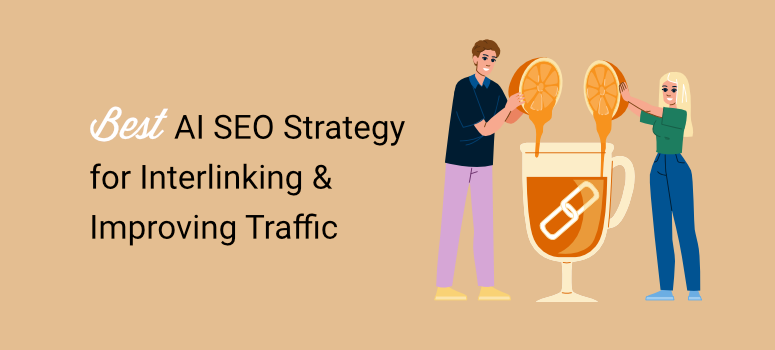As an SEO expert with 10 years of experience, I used to love manual internal linking. While others relied on automation, I discovered opportunities they were missing by conducting thorough content analysis before adding a single link.
As my business grew, I invested in expensive SEO tools like SEMRush and Ahrefs.
But this still frustrated me because it required endless manual work to find the right internal link. I would spend hours analyzing data and then spend even more hours adding the actual links in the WordPress sites.
Everything changed when I discovered WordPress SEO tools that actually connect automation and strategic control. As an SEO and WordPress expert, this connection was a game changer.
Remember that AI is changing search behavior and sites need real subject expertise to dominate.
And networking is one of the best ways to achieve this.
This means that the manual approach to internal linking cannot be scaled, while pure automation lacks an SEO strategy.
The solution? WordPress plugins that understand both SEO strategy and WordPress implementation.
I’ll show you my proven system for building topic authority using three powerful tools: AIOSEO for intelligent internal linking, LowFruits for strategic keywords, and SEOBoost for AI content optimization.
What you will learn:
- Master AIOSEO’s Link Wizard for automated internal linking
- Use LowFruits to identify opportunities for topic authority
- Use SEOBoost’s AI for maximum content impact
- Build the expertise that will make you a recognized niche expert
With that out of the way, let’s first look at what you need before setting up WordPress link automation.
What you need before we begin
Before we dive into this authority building strategy, let’s make sure you have everything ready. This setup takes about 2-3 hours but creates a system that works for months.
Required tools:
Check out the table below to see how I use each of these SEO tools in my internal linking strategy.
| Tool name | Main purpose | Specific functions used | Role in establishing authority | Expected results |
|---|---|---|---|---|
| AIOSEO (Link Assistant) | An automated internal linking system that finds strategic connections | Link Opportunities Dashboard, Bulk Link Adding, Cornerstone Content Marking | Created a hub-and-spoke architecture that connects pillar pages to clustered content | New strategic links, improved engagement, elimination of orphan posts |
| Low fruits | Strategic keyword research for low competition opportunities | Keyword finder, SERP weakness analysis, keyword clustering | Identifies topic clusters and content hierarchies for comprehensive expertise | 3-5 main topic clusters, better keyword opportunities, clear content architecture |
| SEOBoost | AI content optimization for maximum linking potential | Content analysis, gap analysis, real-time scoring | Creates link-worthy content by optimizing pages according to government standards | High-quality results, comprehensive pillar content, improved topic depth |
Skill level: Beginner with basic SEO knowledge. You should understand concepts like internal links, keywords, and content optimization, but I’ll explain the advanced techniques step by step.
If you need a refresher course, start by reading my complete SEO WordPress guide.
Time investment:
- Initial setup: 2-3 hours
- Weekly maintenance: 30 minutes
- Monthly optimization: 1 hour
What we will achieve: By the end of this tutorial, you will have an automated system that identifies and implements strategic internal links in your content.
This will help you position yourself as a comprehensive expert in your niche.
Why AI-supported linking builds topic competence
In the past, search engines like Google have ranked pages with precise keywords and lots of backlinks. No longer!
Nowadays, Google no longer just ranks individual pages. Instead, websites are evaluated based on comprehensive topic expertise.
Think about it this way.
When someone searches for “content marketing,” Google wants to direct them to a website that covers everything related to content marketing, not just an article that randomly mentions it.
The new search reality is that, thanks to AI-powered results, over 58% of search queries now end without clicks.
While this approach has upended traditional SEO strategies, it also means Google is getting better at understanding complete topics, not just keyword matches.
As a result, websites that demonstrate in-depth knowledge across entire subject areas are rewarded. But sites with scattered, disjointed content are left behind.
Why internal linking signals expertise:
Internal links tell Google how your content is linked.
If you link from your “content marketing strategy tools” article to a more detailed article in the same area, e.g. B. “Best email newsletter plugins” show Google that these topics are relevant and that you understand them.
When you do this strategically across dozens or hundreds of articles, Google begins to view you as a comprehensive source.
This is current authority!
The manual problem:
Most people try to build internal links manually. You remember to add a few links here and there. But creating the extensive network of connections required for real authority? Almost impossible by hand.
The AI solution:
Intelligent automation finds every opportunity. Tools like AIOSEO Link Assistant Analyze your entire content library and identify connections you would never see manually.
Additionally, when you combine LowFruits’ strategic keyword research with SEOBoost’s AI content optimization, you create content specifically designed to build authority.
The result? You become the go-to expert that Google recommends when people search in your topic area.
How to develop an effective AI-connected SEO strategy
Now that you understand the shift in SEO, let’s see how you can take full advantage of AI in improving your internal linking process.
Now I’ve divided this strategy into sections to make it easier for you to follow. To read a specific step, click one of the links below.
With that said, let’s get started.
Part 1: Set up AIOSEO Link Assistant
Time frame: 20 minutes
AIOSEO Link Assistant is a premium all-in-one SEO feature that automatically scans your content and suggests strategic internal links to build topic expertise.
Think of it as your personal linking strategist, analyzing every piece of content and finding opportunities you would never discover manually.
Install and activate Link Assistant
While AIOSEO offers a free SEO plugin, you can only use the Link Assistant feature on the Pro plan or higher.
You can check out this AIOSEO Pro vs Free post to see the difference between the two versions.
First, make sure AIOSEO Pro or Elite is installed on your WordPress site. All you have to do is go to the officer All-in-one SEO website and purchase a plan.
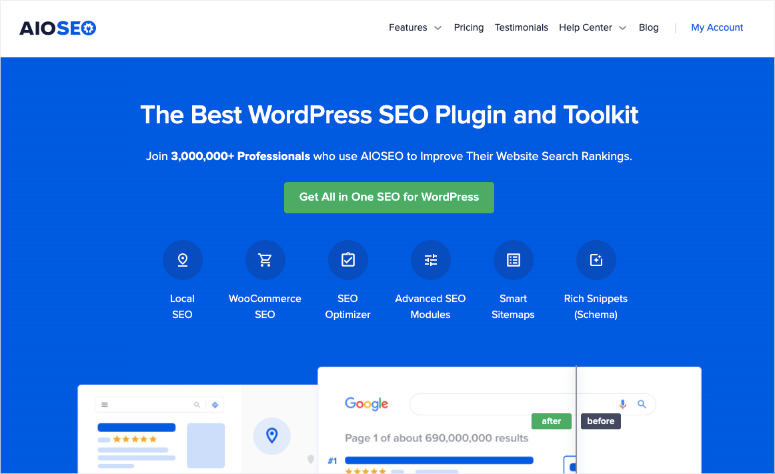
Next, go to your AIOSEO dashboard and navigate to “Downloads”. Download the ZIP file to your PC here. And while you also copy the license key here, you will need it later to activate the Pro version.
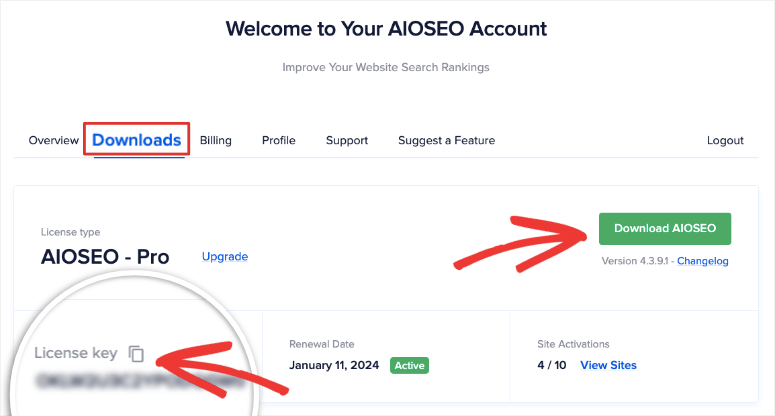
Next, go to your WordPress dashboard and install the AIOSEO plugin like any other plugin.
If you run into any problems, check out my detailed guide on installing plugins here.
After installation, go to AIOSEO » General Settings and enter your license key to unlock all premium features.
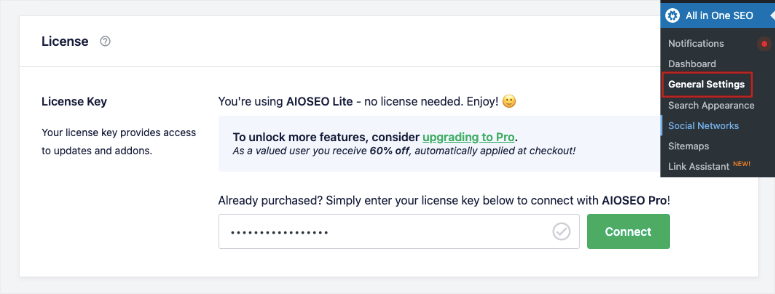
Next go to AIOSEO » Feature Manager to view a list of available add-ons. Then search for “Link Assistant” and toggle it Active.
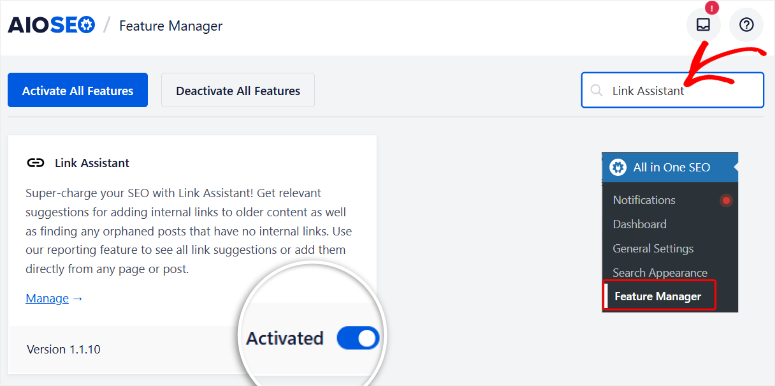
Once you activate it, AIOSEO will start crawling your website in the background.
AIOSEO then visualizes the important issues, recommended improvements, good results and more in graphs and charts.
This first crawl can take 10 to 30 minutes depending on the volume of content.
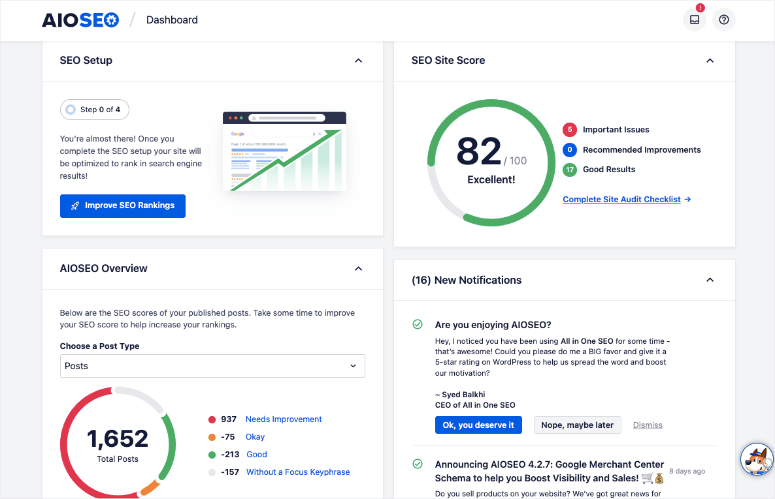
Understanding your Link Assistant dashboard
After the SEO scan, navigate to AIOSEO » Link Assistant » Overview to access your command center for building topic authority.
Here’s what each metric means:
- Crawled posts: Total content parts that were analyzed for linking possibilities
- Orphaned posts: Content without inbound internal links. These are authority killers
- Internal links: Total number of internal connections on your website
- External links: Links that point to other websites
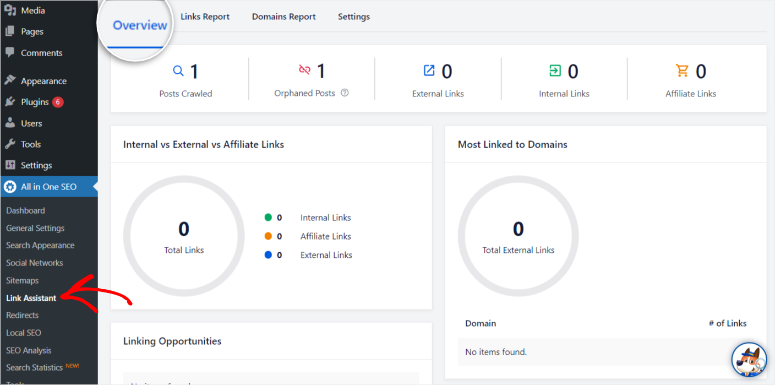
You’ll probably see some insightful numbers here.
For example, most websites have 20-40% orphan content, which are pages with no inbound internal links. These present immediate opportunities to strengthen the authority of the topic.
My strategy is to make sure every page and post has at least 3-5 internal links for every external link. This keeps link equity flowing within your site instead of leaking to the competition.
Let me show you how to make this linking strategy a reality.
Configure strategic settings
Next, select AIOSEO » Link Assistant » Settings to configure your automation settings.
Then, under Post Typesselect which content types to analyze. For example, I check Published, Scheduled, Draft, Pending, and Private. If you have custom post types for products or portfolios, include those as well.
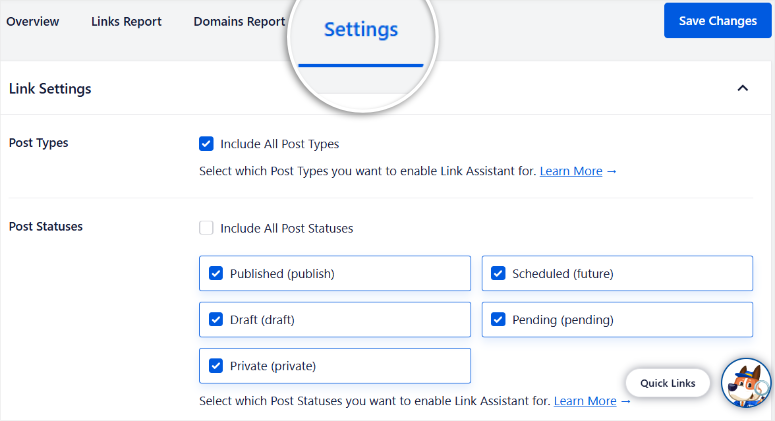
Then scroll down this page and look for these important options:
- Words to ignore: Add general terms that you don’t want to be automatically linked. For example, if you constantly write about “marketing,” you might ignore it to avoid overlinking.
- Phrases that should be skipped at the beginning: Set this to 2-3. This prevents links from cluttering your introductions.
- Here is my personal trick: Use the Exclude Pages/Posts feature to remove low-quality or outdated content from link suggestions.
- This ensures that link equity flows only go to your best and most relevant pages that support your topic authority strategy.
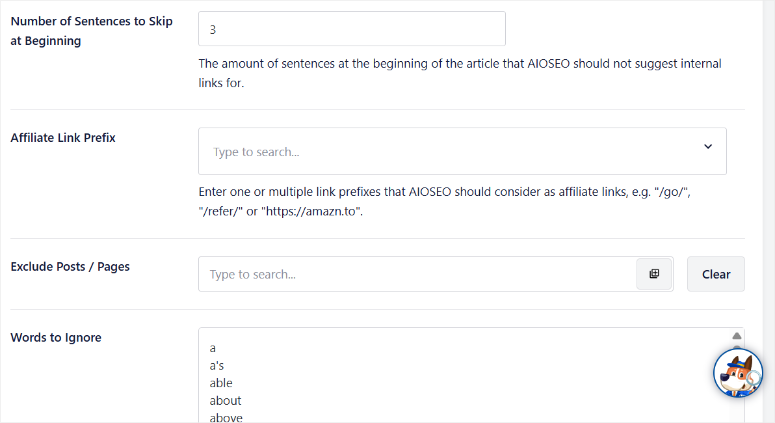
Quick verification test
After setting up the Link Assistant feature, make sure everything is working properly. To do this, go to AIOSEO » Link Wizard » Link Report and select the “Link Opportunities” filter.
Your posts will be displayed here with linking options including publication date, internal and external links. If you run an affiliate website, you will also see affiliate links.
Here you can quickly identify pages and posts that have few internal links before you start the process.
Additionally, you can open the individual pages and manually add the internal links you want.
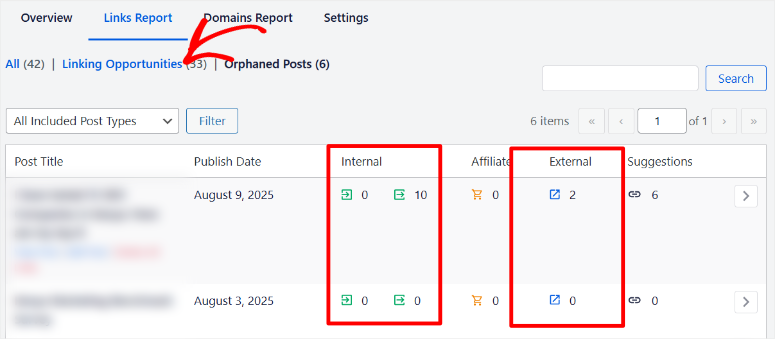
Not only can you see all pages with linking options, but also pages without links! We call these orphaned posts.
To see these posts, go to Orphaned Posts Tab. You will see the same metrics as in the Link Chance tab.
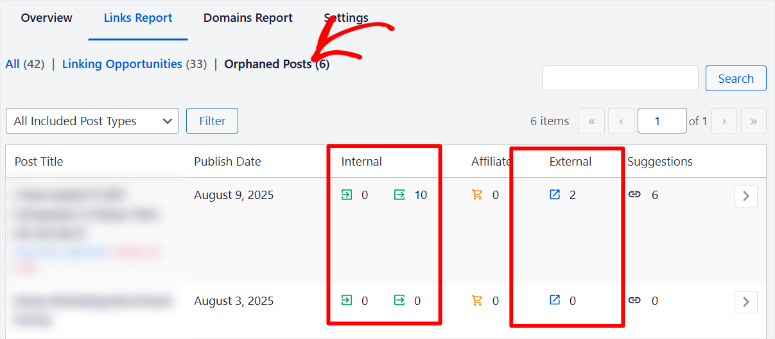
But now comes the fun part. On both Link option or Orphaned Posts Tabs there is a small arrow at the end of each post. Select it to open link options for each post.
You will receive suggestions for both inbound internal and outbound internal links. As a result, you can both add links leading to the post and leave the post.
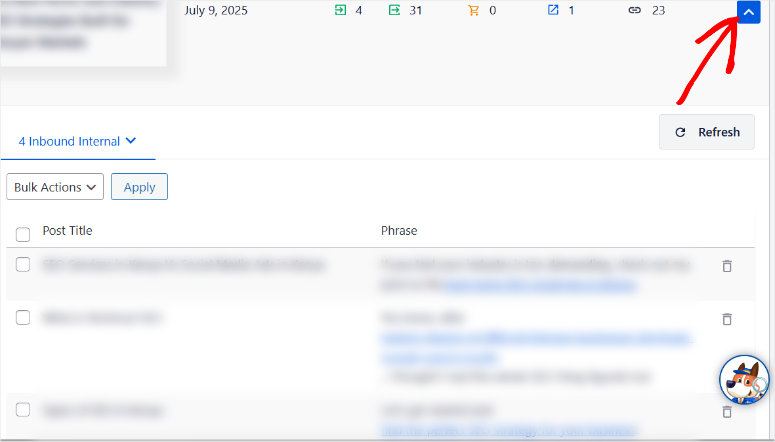
That’s it! You can use these suggestions to automate your linking.
Check out the latest AIOSEO review to see what you can do with this SEO plugin.
This lays the foundation. Next, we use LowFruits to identify the strategic keywords that guide your linking decisions.
Part 2: Strategic Keyword Research with LowFruits
Time frame: 25 minutes
Before AI overviews and AI SEO came along, we optimized individual pages for individual keywords.
But now topic authority is the best SEO approach. Today we are creating content clusters. This means we group related topics and keywords. Then create content around that topic to demonstrate your expertise.
LowFruits excels at finding those cluster opportunities, especially the “low-hanging fruit” keywords where you can actually compete.
I’ll show you how to use LowFruits to identify clusters and then link these content groups together.
Setting up your LowFruits analysis
First, you need a LowFruits account. So, go to them Visit the official website and sign up for a plan. The best part is that you can start with a free trial to see if lowFruits is actually right for you.
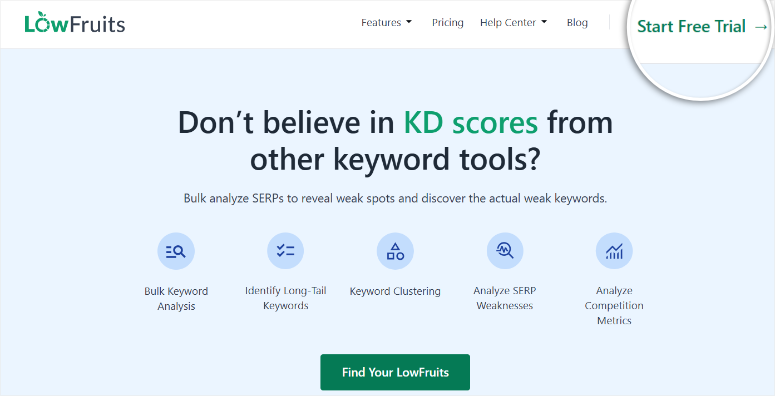
Next, log in to your LowFruits account and go to Keyword Finder Tool. Here we identify the foundation of your topic authority strategy.
Start with your main topic area. If you’re in digital marketing, don’t just search “digital marketing.” Instead, try broader seed terms like:
- “Content Marketing Tips”
- “Email Marketing Strategy”
- “Social media marketing”
Enter your first seed keyword here and click Generate.

The reason I use this SEO tool is because LowFruits actually looks at actual search results and not just the keyword difficulty scores that other tools rely on.
Understanding the opportunity signals
Pay attention to LowFruits’ unique visual indicators:
Green fruit symbols: These show keywords for which low authority websites rank in the top 10. Perfect goals for your internal linking strategy.
SERP weakness scores: Look for Domain Authority (DA) scores less than 20. These indicate opportunities where strategic content and internal linking can help you outperform current results.

Keyword clusters: LowFruits automatically groups related keywords. These clusters become your blueprint for topic competency.
What I like about this approach: Instead of chasing competing keywords, it finds gaps where comprehensive topic coverage can be beneficial.
Create your topic cluster map
Next, select the Clusters Click the tab to see how your keywords group together naturally. This reveals your content architecture for maximum topic authority.
For example, a “content marketing” cluster might include:
- Content Marketing Strategy (Pillar Page)
- Marketing tips (cluster page)
- Blog Content Ideas (Cluster Page)
- Content calendar templates (cluster page)
- Content marketing metrics (cluster page)
Each cluster needs a comprehensive pillar page that covers the broad topic, supported by multiple detailed cluster pages.
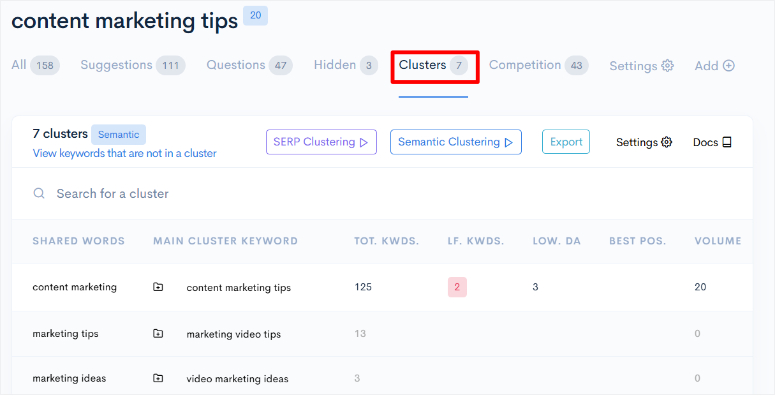
Exporting your strategic keywords
Once you have identified 3-5 main topic clusters, export them using export Button.
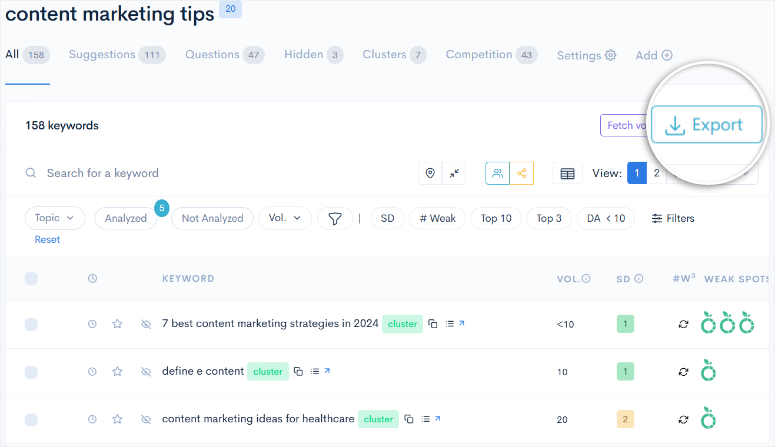
Remember to save this as a spreadsheet since you’ll be referring to it constantly. Create three columns in your table:
- Column pages: Broad topics for comprehensive reporting
- Cluster pages: Specific subtopics that support pillars
- Long tail content: Detailed articles that reference clusters
This hierarchy becomes your internal linking roadmap. Each piece of content should be logically connected to others in its cluster.
The opportunity to build authority
As you can see, LowFruits doesn’t just find easier keywords; It uncovers gaps in topics where you can create detailed guides instead of random pieces of content.
Don’t try to create content for every keyword right away. Start with a cluster of around 5-8 related keywords. Then build up this topic expertise first before expanding it to new clusters.
This focused approach creates the comprehensive expertise that Google rewards with higher rankings across your entire subject area.
For a complete overview of how this SEO tool works, check out my full LowFruits review.
Once your keyword clusters are mapped, it’s time to optimize your content with SEOBoost for maximum linking potential.
Part 3: Content optimization with SEOBoost
Time frame: 20 minutes
The truth is that internal linking only works if you link to truly valuable content. Random internal links only confuse Google and dilute your topic’s authority signals.
This is why I use SEOBoost to make sure every article is worth linking to before implementing an internal linking strategy.
Analyze your topic competition
First, you need an SEOBoost account. To get one, visit the official SEO tool Visit the website and purchase a plan.
Like LowFruits, I recommend you start with SEOBoost’s 14-day free trial to see if it’s right for you.
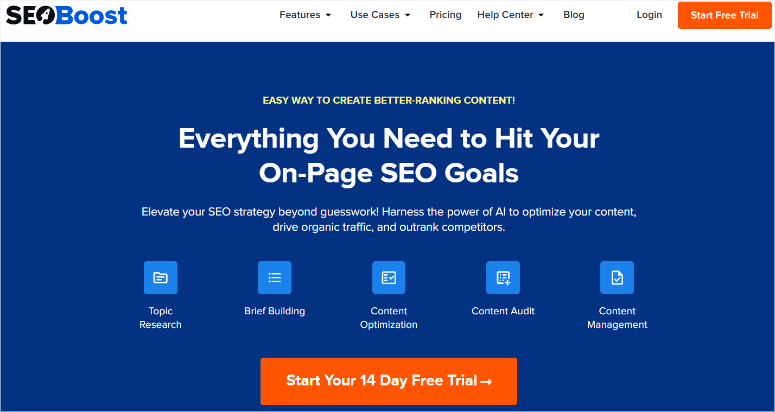
Next, log in to SEOBoost and navigate to Content analysis Tool. Then enter your primary keyword from your LowFruits cluster research.
Next, SEOBoost analyzes the top 30 search results and shows you exactly what type of content Google rewards in your niche.
Pay attention to these key metrics:
- Average word count from ranking sites
- Depth of content and topic reporting
- Semantic keywords Take advantage of competitors
- Content structure Pattern
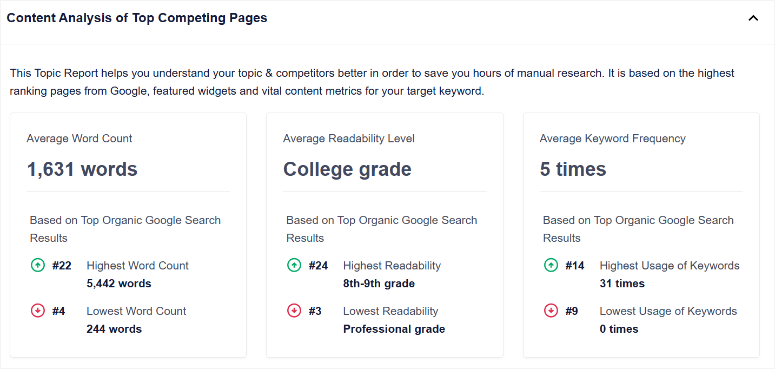
This is not about copying competitors. It’s about understanding the basic content quality needed to justify internal links.
The strategic content gap analysis
You can also use the SEOBoost content analysis report to find content gaps that competitors are completely missing and uncover your biggest opportunity.
On the Content analysis report On the Top Competitor Sites Overview page, navigate to the tab.
Here you’ll see each ranking page with essential metrics including SEO scores, word counts, readability levels, and content structure.
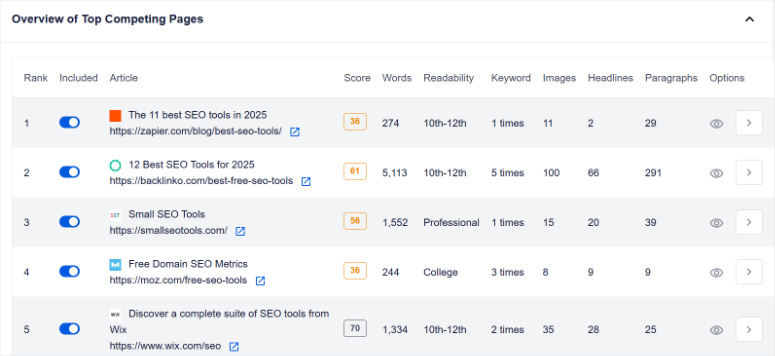
Click the expansion arrow next to a competitor’s URL to view their heading structure and topic coverage. This will show you exactly what they cover and what they don’t.
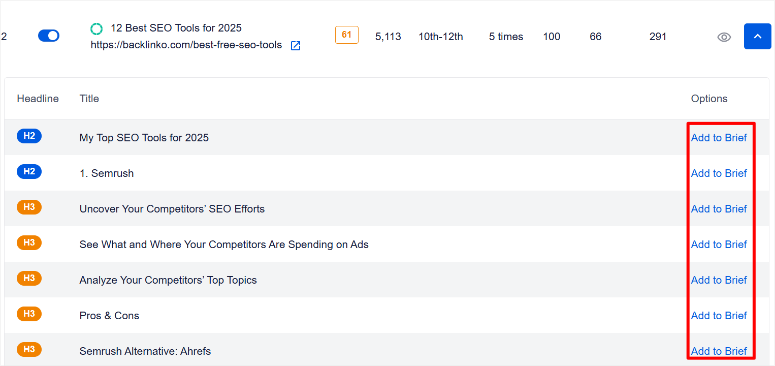
To take full advantage of my linking strategy, look for patterns across multiple competitors and don’t just randomly add headings to your brief.
If the top 3 ranking pages all skip a subtopic that your LowFruits research says people are looking for, you’ve struck gold.
This helps you create comprehensive content that fills these gaps and gives you natural internal linking opportunities that the competition can’t match. They literally cover territory that they have left unexplored.
This content gap approach creates deep expertise that Google rewards with higher topic authority across your entire content cluster.
Create authority-worthy pillar pages
Next, use SEOBoosts Table of contents With this feature, we’ve added topics for your pillar page keywords to the guide. This creates comprehensive overviews that show exactly what needs to be covered for maximum authority.
For example, a “content marketing strategy” pillar page might require:
- Over 15 subtopics for comprehensive reporting
- At least 2,500-3,500 words
- Over 25 semantic keywords naturally integrated
- Clear section structure for easy linking
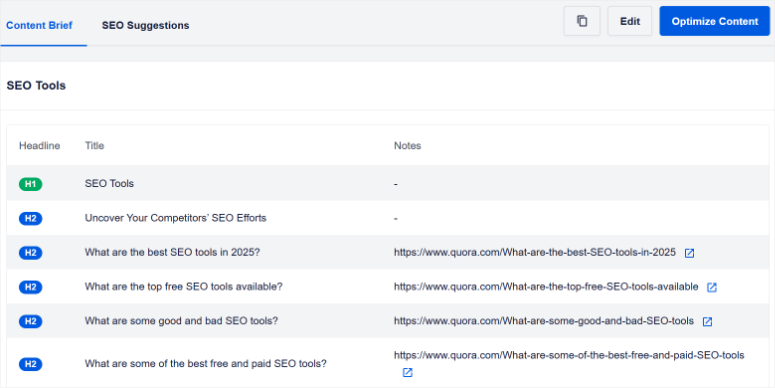
My approach is to create pillar pages that are the best resource for the topic. When other content links to them, it feels natural because they really deserve the link.
Optimizing existing content for link worthiness
Once done, run your existing content through SEOBoost Content review Special feature. This shows which pages need to be optimized before they become effective internal linking targets.
Look for content with a score below 70/100 in SEOBoost. These pages need to be edited before you start sending them internal links.
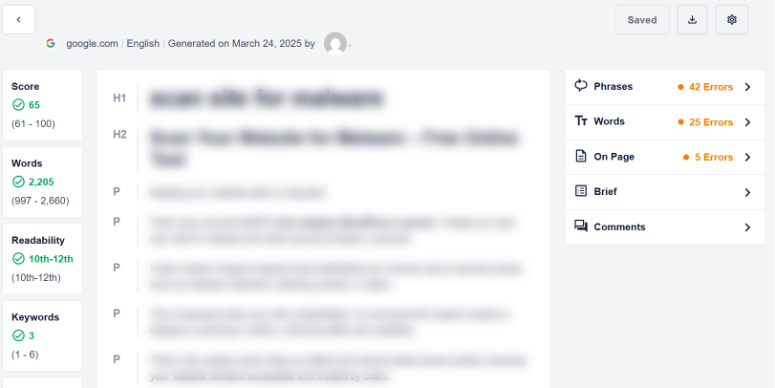
Common problems I see:
- Thin content This does not justify links from comprehensive articles
- Missing semantic keywords This would make linking feel natural
- Poor structure This makes it difficult to reference specific sections
Quality control for link targets
Before implementing your AIOSEO internal linking strategy, perform a final audit of your most important pages using SEOBoost’s real-time scoring.
Every page should have a score above 80 before it becomes a major internal linking destination. This ensures that your automated linking actually builds authority and not just creates a lot of work.
The result? When AIOSEO suggests linking to your optimized content, these links have real value for both users and search engines.
Benefits of WordPress integration
Now SEOBoost is quickly becoming my favorite content optimization tool because it works directly in WordPress via the AIOSEO integration.
In short, SEOBoost acts as AIOSEO’s built-in writing assistant. So once you connect both tools, you can optimize content without ever leaving your WordPress dashboard.
All you need to do is go to your WordPress site or post editor and look for the “Create New Report” option at the bottom of the “AIOSEO Settings” section.
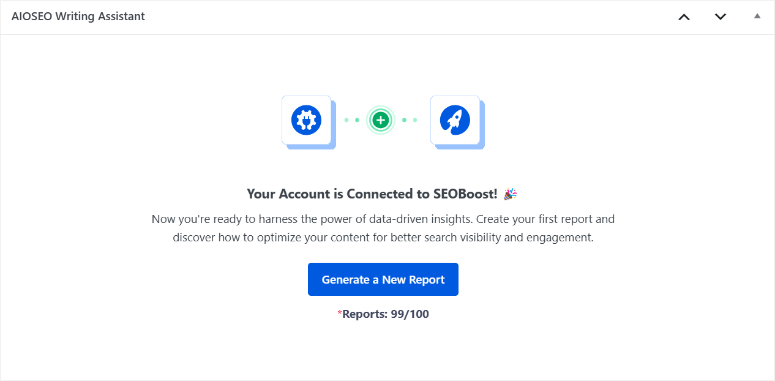
Enter your target keyword, search region and language. SEOBoost then generates a comprehensive optimization report directly in your WordPress editor without having to switch platforms.
The report includes three main sections:
- Overview: The SEO rating of your content compared to the top 30 competitors
- Optimization assistant: Related terms and their usage recommendations
- List of participants: Benchmarks of currently ranking pages

The best part? Everything is synced between your SEOBoost dashboard and WordPress. As a result, reports you create in WordPress appear under “Theme Reports” in your SEOBoost account.
This seamless integration means you can optimize content without the constant platform switching that hinders productivity.
In the end, you can research in SEOBoost, optimize in WordPress, and then implement internal links via AIOSEO – all in one connected workflow.
Now that your content is optimized for maximum impact, you can implement the strategic internal linking system that turns scattered pages into comprehensive topic expertise.
Check out my full SEOBoost review for full details on how to make the most of its powerful features.
Implementing your link strategy to build authority
45 minutes | Combine all three tools in one powerful system
Everything fits together here.
- Your LowFruits keyword clusters guide the strategy.
- Your SEOBoost optimized content delivers worthy link targets.
- Now AIOSEO Link Assistant automates large-scale implementation.
Even though we discussed this above, I’ll show you step by step how to use my linking strategy.
Step 1: Highlight your strategic content priorities
First, we need to tell AIOSEO which pages are most important – your pillar pages identified through LowFruits clustering.
Navigate to each pillar page in your WordPress editor. Scroll down to AIOSEO settings Select and switch sections Cornerstone content to ON.
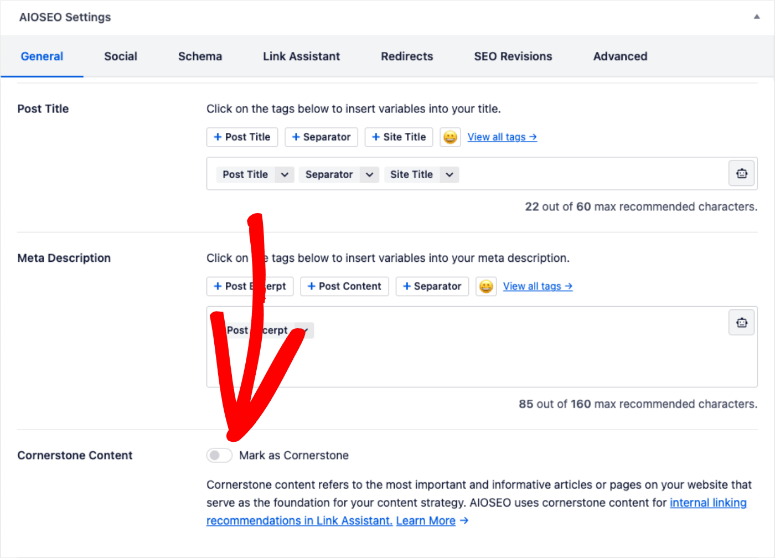
We do this because the Link Assistant AIOSEO feature prioritizes these pages in its recommendation algorithm.
This will give your cornerstone content more linking suggestions and appear with special building icons throughout the interface.
I typically mark 3-5 pillar pages per topic cluster. Anything less weakens the signal of authority you’re trying to build.
Step 2: Access your Linking Opportunities dashboard
Next, go to AIOSEO » Link Wizard » Link Report and select the “Link Opportunities” filter. This reveals your automation goldmine.
Each post shows two critical metrics:
- Incoming internal suggestions: Links to this content from other sites
- Outgoing internal suggestions: Links from this content to other sites
The magic happens when you see both numbers. This indicates content that deserves links AND can be strategically linked to other relevant pieces.

Step 3: Link everything together
Here is my simple approach that builds maximum authority:
Start with your most important pages first and then connect related topics. Work through your content step by step to create clear, meaningful connections.
1. Start with the cornerstone priority.
- Click on posts that contain suggestions that link to your cornerstone pages (look for posts with numbers in the Suggestions column).
- Check out the individual link suggestions that appear as you expand each post
- Add the most relevant suggestions that connect to your pillar pages first
- This signals to Google that these pages are your most important resources

2. Next, connect the cluster content.
- When doing your LowFruits research, look for posts within the same keyword clusters
- Click on posts that can link to related articles in each subject area
- Focus on suggestions that connect pages on similar or related topics
- These natural relationships create the thematic coherence that Google rewards
3. Build your support structure.
- Find posts where long-tail articles can link to relevant cluster and pillar pages
- Click through posts that cover specific, detailed topics
- Add suggestions that link to your broader, more comprehensive content
- This creates an upward link equity flow that builds authority
The process works by clicking on individual posts with suggestions, looking at the specific linking opportunities, and adding the ones that make sense for your topic authority goals.
Within 30 minutes of continuous work, you’ll transform scattered content into a connected network that Google will recognize and reward.
Step 4: Optimize your anchor text strategy
I always advise you not to use AIOSEO’s default anchor text suggestions without checking. Instead, hover over a suggestion and click Edit icon adjust.
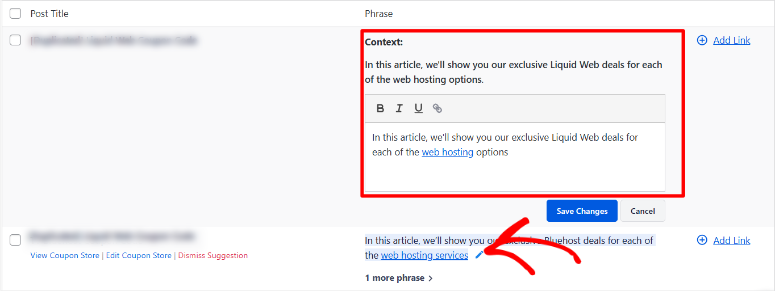
Use your LowFruits keyword research as a guide for selecting anchor text:
- Column pages: More comprehensive, authority-building terms
- Cluster pages: Specific semantic keywords
- Long tail content: Natural, descriptive sentences
My rule is to ensure that the anchor text feels natural to the reader while also containing strategic keywords that reinforce thematic relevance.
Also, avoid one- or two-word anchor texts. You need to give both Google and your users context about the link to give it more weight. Instead, try three or four word anchor texts.
Step 5: Fix orphaned content
One of the biggest threats to your website’s authority is orphan pages. As already mentioned, these are pages on your website that do not have any internal links pointing to them from other pages.
Think of it this way: If Google can’t easily find these pages through your site’s link structure, it assumes they’re not important. Additionally, visitors cannot discover this content naturally while browsing your website.
As a result, orphan pages affect your topic authority because they are not connected to your content clusters. Instead of contributing to your competence signals, they simply waste potential.
To resolve this issue, navigate to AIOSEO » Link Assistant » Overview and check yours Orphaned posts to count.

Here, make sure you fix these orphaned pages by adding relevant inlinks and outlinks. You should always focus on the content quality and keyword relevance for your topic clusters.
I always strive to ensure that there are no orphaned posts on authority sites. In the end, every piece of content should connect logically to your topic ecosystem.
Step 6: Configure quality control settings
To make this process even faster, the AIOSEO Link Assistant feature now offers a bulk edit option.
This allows you to select multiple link suggestions using the checkboxes on the left and then add them all at once with a single click.
This is a huge time saver because instead of having to individually click “Add Link” dozens of times, you can process entire batches of strategic internal links in seconds.
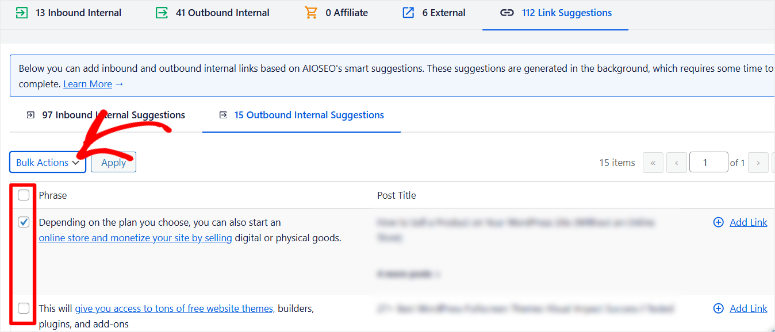
Before adding hundreds of links in bulk, set strategic boundaries AIOSEO » Link Assistant » Settings:
- Words to ignore: Add general terms to prevent overlinking
- Phrases that should be skipped at the beginning: Set the value to 2-3 to avoid confusing introductions
- Exclude posts/pages: Remove low-quality or outdated content from link suggestions so link equity flows only to your best and most relevant pages

The result?
Your SEOBoost optimized content is strategically linked through internal links driven by LowFruits keyword clusters.
This creates the comprehensive topic authority that Google recognizes and rewards with higher rankings across your entire content library.
Congratulations! You can now create topic expertise through connections and good content structure. This approach allows search engines to place your content on the most relevant search results pages.
Additionally, your readers will view you as an authority in the field because not only will you show them content on the topic, but you will also show through your internal links that you understand the topics surrounding the topic.
How to track content performance
Building topic expertise through strategic linkage is not a “put it down and forget it” process. You need to track certain metrics to see if your linking strategy is actually working and where you can improve it.
So how do you actually track the performance of your content?
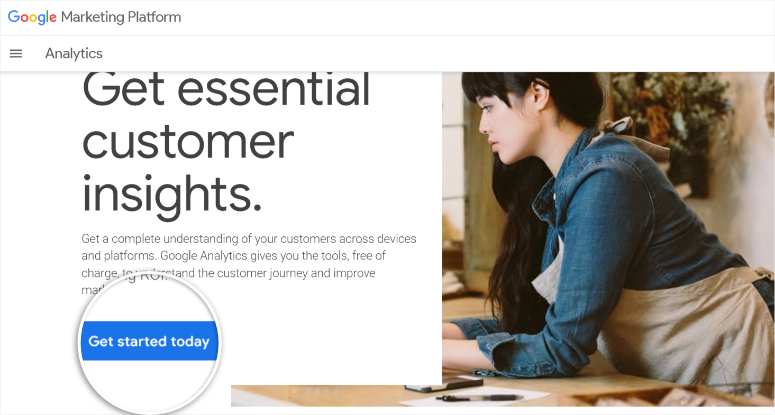
Open first Google Search Console and navigate to Links » Internal links. Within two to three weeks, your cornerstone pages should appear in the Top Linked Pages section.
In Google Analyticsmonitor these key indicators:
- Pages per session increase (Users explore more content)
- Session duration improvements on pillar pages
- Reduced bounce rate to previously orphaned content
Check out these guides to properly set up the metrics above and more.
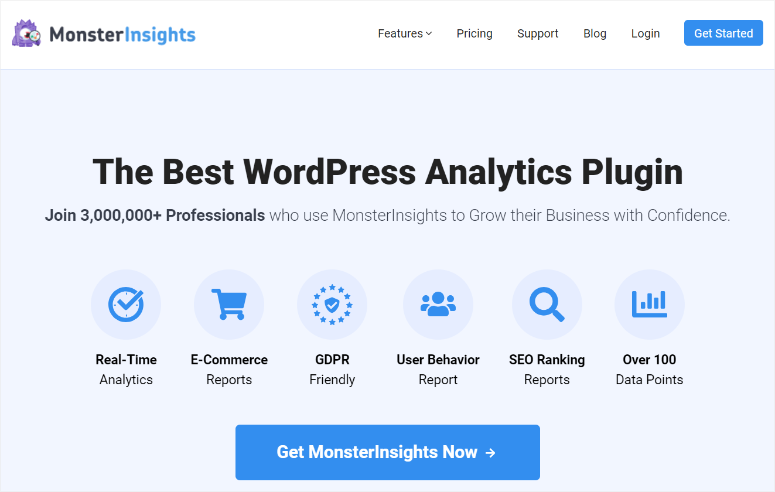
Are you looking for a more efficient way to track the performance of your content?
To keep with the theme of simplicity of this guide, I recommend using it MonsterInsights. This allows you to see your Google Analytics metrics without ever leaving your WordPress dashboard.
The plugin shows your internal linking success directly in WordPress:
- Best performing sites through increased internal linking
- User behavior flow between linked content
- Engagement Improvements on previously orphaned posts
Check out my full MonsterInsights review here.
Apart from that, here are other WordPress statistics plugins you can use instead:
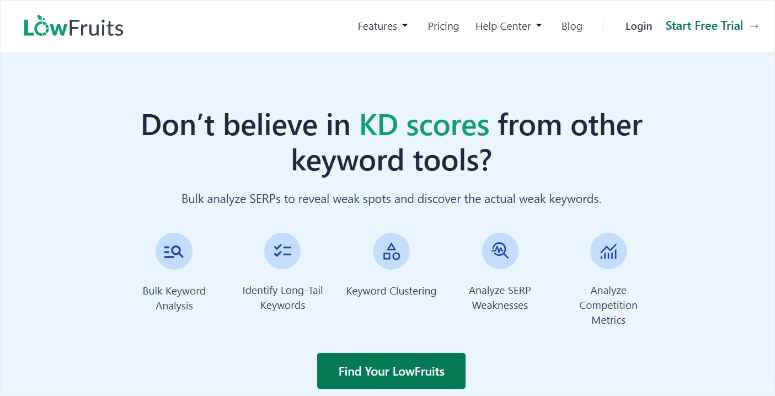
You can also use LowFruits’ built-in keyword tracker to monitor the performance of your target keywords over time.
Since you’ve already identified your keyword clusters during the research phase, add these keywords to the tracker to see if your internal linking strategy helps you improve rankings.
The tracker shows position changes so you can see which topic clusters are gaining authority and which need more internal linking support.
How to scale your topic authority
As you can see, building topic authority is not a one-time affair. It is an ongoing process that builds over time. This is how I maintain and scale the system for maximum expert positioning.
Monthly maintenance routine
- Week 1: Check new linking opportunities in the AIOSEO Link Assistant. Add 10-15 high-quality connections between related content.
- Week 2: Perform an orphan content audit. All new pages without inbound links get immediate attention.
- Week 3: Use LowFruits to identify new keyword opportunities within your existing topic clusters. Plan content that fills gaps.
- Week 4: SEOBoost audit of cornerstone pages. Make sure your most linked content has an optimization score of over 80.
This 30-minute weekly routine prevents loss of authority and identifies opportunities for expansion.
Long-term authority building tactics
- Go into fewer topics in depth firstinstead of treating many topics lightly. Instead of covering 10 topics superficially, you will have complete mastery of 3-4 subject areas.
- Create content specifically for internal linking. If you find a gap in your topic coverage, create comprehensive content to serve as an important link hub.
- Monitor competitor topic expansion. Use SEOBoost’s competitor analysis to see when competitors are moving into your subject areas. Create top-notch content and link to it strategically.
That’s it! You are now well-equipped to dominate your niche with content authority through networking.
This will make you the website that Google automatically considers when someone searches for a keyword in your subject areas.
If something is unclear, check out the frequently asked questions below.
FAQs: How I use interlinking to improve traffic
How many internal links are too many on a single page?
I aim for 8-12 internal links per 1,500 word article. The key is not to hit a certain number, but to ensure that each link provides real value to readers. The AIOSEO Link Assistant helps by only suggesting context-relevant options. If a page seems crowded or links seem forced, you’ve gone too far.
Can this linking strategy work with any WordPress theme?
Absolutely. AIOSEO Link Assistant works at the content level, not the topic level. I’ve implemented this on everything from simple blog topics to complex business sites. The internal links appear as standard HTML links that will work with any properly coded WordPress theme.
What if I have a small website with limited content?
Start with what you have. Even 20-30 pieces of content can benefit from strategic internal linking. Focus on creating two to three solid topic clusters rather than trying to cover everything. As you add content, AIOSEO automatically finds new linking opportunities. When it comes to building authority, quality trumps quantity.
How long before I see improvements in topic authority?
Most sites start seeing improvements within 4-6 weeks. MonsterInsights first shows more pages per session and longer interaction times. Rankings typically improve within 8 to 12 weeks as Google recognizes your comprehensive topic coverage. Remember that building authority is a marathon, not a sprint.
Final Thoughts: Is internal linking so important for SEO?
Yes that’s it. In fact, it’s more important now with Google’s new ranking approach.
Additionally, building topic expertise through strategic internal linking has changed the way I approach SEO.
Instead of chasing individual keyword rankings, I now create comprehensive expertise that positions me as the go-to source in my niche.
Combining AIOSEO Link Assistant’s automation, LowFruits’ opportunity detection, and SEOBoost’s content optimization creates a system that scales as you grow.
Additionally, tools like MonsterInsights keep you informed without the complexity.
Most importantly, this approach creates lasting value. While others look for algorithm updates, create a comprehensive resource that deserves top rankings on Google regardless of the changes.
Resource Center
Building topic expertise is just one part of your overall SEO strategy. Check out these related guides to further improve your WordPress site’s search performance.
These guides will help you build a complete SEO foundation that fits your new internal linking strategy.
Start with one resource that meets your greatest need, then leverage the others as your site grows.

